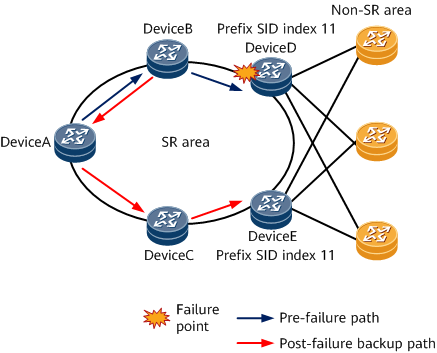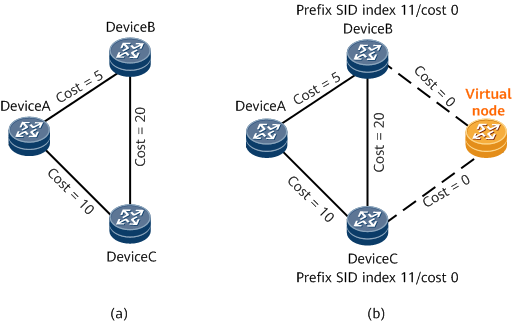Anycast FRR
Anycast SID
An anycast SID is the same SID advertised by all routers within a group. On the network shown in Figure 1, DeviceD and DeviceE both reside on the egress of an SR area, and traffic can be forwarded to the non-SR area through either DeviceD or DeviceE. Therefore, the two devices can back up each other. In this situation, DeviceD and DeviceE can be configured in the same group and advertise the same prefix SID, the so called anycast SID.
The next hop of the anycast SID is DeviceD, which has the smallest IGP cost in the router group. DeviceD is called the optimal node that advertises the anycast SID, and the other device in the group is a backup node. If the primary next-hop link or direct neighbor of DeviceD fails, traffic can reach an anycast SID device through a protection path. The anycast SID device can be the source that has the same primary next hop or another anycast source. When VPN traffic is forwarded over an SR LSP, the same VPN label must be configured for anycast.
Anycast FRR
Anycast FRR allows multiple nodes to advertise the same prefix SID. Common FRR algorithms can only use the SPT to compute a backup next hop. This applies to scenarios where a route is advertised by a single node instead of multiple nodes.
When a route is advertised by multiple nodes, these nodes must be converted to a single node before a backup next hop is computed for a prefix SID. Anycast FRR constructs a virtual node to represent the multiple nodes that advertise the same route and uses the TI-LFA algorithm to compute a backup next hop to the virtual node. The anycast prefix SID inherits the backup next hop from the virtual node. This solution does not involve any modification of the algorithm for computing the backup next hop. It retains the loop-free trait so that no loop occurs between the computed backup next hop and the primary next hop of the pre-convergence peripheral node.
As shown in Figure 2(a), the cost of the link from DeviceA to DeviceB is 5, and that of the link from DeviceA to DeviceC is 10. DeviceB and DeviceC advertise the same route 10.1.1.0/24. TI-LFA FRR is enabled on DeviceA. Because DeviceA does not meet TI-LFA requirements, it cannot compute a backup next hop for the route 10.1.1.0/24. To address this issue, TI-LFA FRR with multiple nodes advertising the same route can be used.
As shown in Figure 2(b), this function is implemented as follows:
- A virtual node is constructed between DeviceB and DeviceC and connected to both devices over links. The cost values of the links from DeviceB and DeviceC to the virtual node are both 0, whereas those of the links from the virtual node to DeviceB and DeviceC are both infinite.
- The virtual node advertises a prefix of 10.1.1.0/24. This means that the route is advertised by a single node.
- DeviceA uses the TI-LFA algorithm to compute a backup next hop to the virtual node. The route 10.1.1.0/24 inherits the computation result. On the network shown in Figure 2(b), DeviceA computes two links to the virtual node. The primary link is from DeviceA to DeviceB, and the backup link is from DeviceA to DeviceC.

